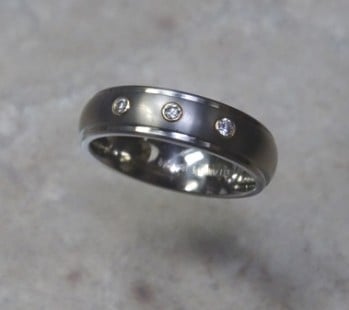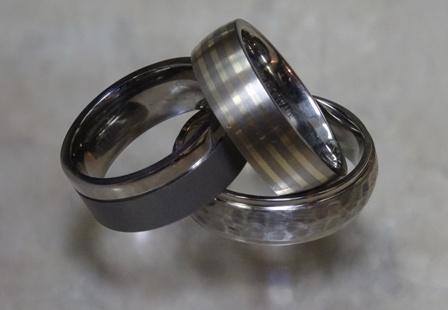
Titanium with diamonds set in gold bezels
There has been a rash of alternative metals making headway in the jewelry industry over the last ten years. They’ve been most popular in men’s wedding bands, but every once in a while, I’ll see some of them pop up in women’s rings. The two major players as far as white metals go are titanium and most recently, cobalt chrome.
Titanium jewelry came on the scene in tandem with tungsten carbide jewelry, the latter of which has since fallen by the wayside. Titanium is a major part of the aerospace and maritime construction industries because of its two claims to fame: the greatest strength-to-weight ratio of any metal, and its extreme corrosion resistance.
Applied to jewelry, that makes for chunky pieces that are virtually weightless in comparison to other white metals and are generally more hypoallergenic than potentially any other jewelry metal option.

Titanium rings
The most common titanium alloy found in jewelry is Ti6Al/4V; it is composed of 90% titanium, 6% aluminum, and 4% vanadium, all of which are considered exceedingly low risks for contact allergies. It is the “workhorse” alloy of titanium, and has been used for parts in everything from aircraft carriers to space shuttles. For this article, “titanium” will refer specifically to this alloy.
Titanium has its limitations. First of all, in the scope of white jewelry metals, 6Al/4V is very obviously gray instead of silvery white. Even in mirror-finish, titanium is not as white as platinum or even palladium. It takes and retains a finish excellently, but it’s simply not white.
Titanium’s durability far exceeds that of platinum, but at the cost of workability. Titanium’s tensile strength and hardness (over three times that of 900 Plat) are overkill from a bench jeweler’s standpoint. It has such springiness that it makes prong settings next to impossible to accomplish. As titanium approaches its melting point, it oxidizes, which ultimately weakens the metal, if it is not worked in an oxygen-free environment. Thus repairs to titanium jewelry must be done at specialized facilities, if at all. Pieces are usually just remade because the materials are so inexpensive.

Cobalt chrome rings
The new kid on the white metal block in alternative jewelry is cobalt chrome. Used for years in orthopedic implants, cobalt chrome is renowned for its wear-resistance and biocompatibility. The alloy that made the jump to the jewelry industry is primarily made up of – you guessed it – cobalt and chromium, but it also has dashes of tungsten and carbon in it. It has been heralded as the great replacement for white gold and platinum by marketing campaigns, but that’s not exactly true. In fact, it isn’t true at all.
Cobalt chrome’s most attractive quality is its price point: it’s a pure white alternative to platinum and white gold at, quite literally, a fraction of the cost. It is also quite a bit harder than Ti6Al/4V, while still remaining fairly malleable, which is an impressive boasting point for a jewelry metal. This makes it extremely scratch-resistant.
Unfortunately, its hardness makes it even more difficult for a jeweler to work with. Most, if not all, cobalt chrome rings you may see with prong-set stones usually have white gold heads because cobalt chrome simply isn’t suited to that kind of work.
Titanium’s place in the jewelry world is largely relegated to inexpensive, hypoallergenic rings and bracelets. Cobalt chrome is great for heavy men’s rings where platinum and white gold become very expensive. Both are excellent price points, but it’s nice to know what to expect from what you’re buying to make sure you’re making the right choice.
Tags: cobalt chrome, custom jewelry, engagement rings, engraving, facets, metals, platinum jewelry, titanium, white gold